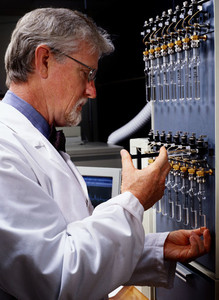Although produced under strict quality control(s) nascent endogenous proteins and glycoproteins (P/GP) are structurally heterogeneous and subject to further structural changes throughout their in vivo life cycle. A nascent polypeptide chain may be subject to co-translational modifications (CTMs) as it is extruded from the ribosome tunnel, e.g. the addition of oligosaccharide; edited for correct folding and initial oligosaccharide processing within the endoplasmic reticulum and subject to post-translational modifications (PTMs) during passage through the Golgi apparatus. The functional activity of a P/GP may be dependent on further chemical modifications (CMs), e.g. deamidation, enzymatic cleavage. These heterogeneities are compounded when determining the structure of a purified P/GP because further CMs may be introduced during its isolation, purification and characterization [1].
When developing a recombinant P/GP (rP/GP) a consensus structure for the endogenous molecule is adopted that it is assumed will be recognized as ‘self’ by the immune system. However, the endogenous CTMs, PTMs and CMs of a P/GP are species and cell specific; therefore, production of a recombinant human P/GP in an alien cell line, e.g. a Chinese hamster ovary (CHO) cell line, may result in the introduction of non-self structures that renders it immunogenic, eliciting the production of anti-drug/therapeutic antibodies (ADA; ATA) responses. Consequently, a candidate rP/GP therapeutic has to be biochemically characterized and shown to be structurally comparable to the endogenous molecule. Recombinant monoclonal antibodies (mAbs) present a particular challenge because each is structurally and functionally unique, thus an endogenous molecule is not available for structural comparison.
It is held that on chronic exposure all recombinant P/GPs are immunogenic, at least in a proportion of patients; however, the incidence and consequences of immunogenicity may vary depending on the disease indication. Short-term treatments for cancer include drugs that target dividing cells, including cells of the immune system resulting in the induction of immunosuppression and/or immune deficiency. In contrast, chronic diseases may exhibit episodes of remission and relapse with repeated exposure to P/GP therapeutics and increased development of ADA. Such immunogenicity may be counteracted by co-administration of a mild immunosuppressant, e.g. anti-TNF-α mAb plus methotrexate. Amongst multiple parameters that impact the immunogenicity of P/GPs aggregation has attracted a particular focus; therefore, rigorous procedures have been developed to quantitate and minimize aggregate formation. Again mAbs are a special case since their mechanism of action (MoA) depends on the formation of immune complexes (ICs), i.e. antigen/antibody aggregates. It has been demonstrated that prior exposure to a mutant form of an mAb therapeutic that does not bind antigen can induce tolerance on subsequent exposure to the active therapeutic [2]. A crucial property of the mutant is its inability to form ICs (aggregates). The size and structure of ICs formed at the time of administration will vary with the relative concentrations of mAb and antigen, the site and route of administration. Fortunately, the tools necessary for such studies are now available.
Conflict of interest
The author of the research paper [1] declared that there were no conflicts of interest.
Abstracted by Roy Jefferis from the Institute of Immunology & Immunotherapy, College of Medical & Dental Sciences, University of Birmingham, UK.
Editor’s comment
Readers interested to learn more about immunogenicity of biologicals are invited to visit www.gabi-journal.net to view the following manuscript published in GaBI Journal:
Immunogenicity assessment of monoclonal antibodies
Immunogenicity of biosimilar monoclonal antibodies
Readers interested in contributing a research or perspective paper to GaBI Journal – an independent, peer reviewed academic journal platform – please send us your submission here.
Related articles
Immunogenicity of biologicals
More immunogenicity data needed for biosimilar mAbs
References
1. Jefferis R. Posttranslational modifications and the immunogenicity of biotherapeutics. J Immunological Res. 2016;2016: 5358272. doi:10.1155/2016/5358272
2. Somerfield J, et al. A novel strategy to reduce the immunogenicity of biological therapies. J Immunol. 2010:185(1):763-8.
Permission granted to reproduce for personal and non-commercial use only. All other reproduction, copy or reprinting of all or part of any ‘Content’ found on this website is strictly prohibited without the prior consent of the publisher. Contact the publisher to obtain permission before redistributing.
Copyright – Unless otherwise stated all contents of this website are © 2016 Pro Pharma Communications International. All Rights Reserved.








 0
0











Post your comment